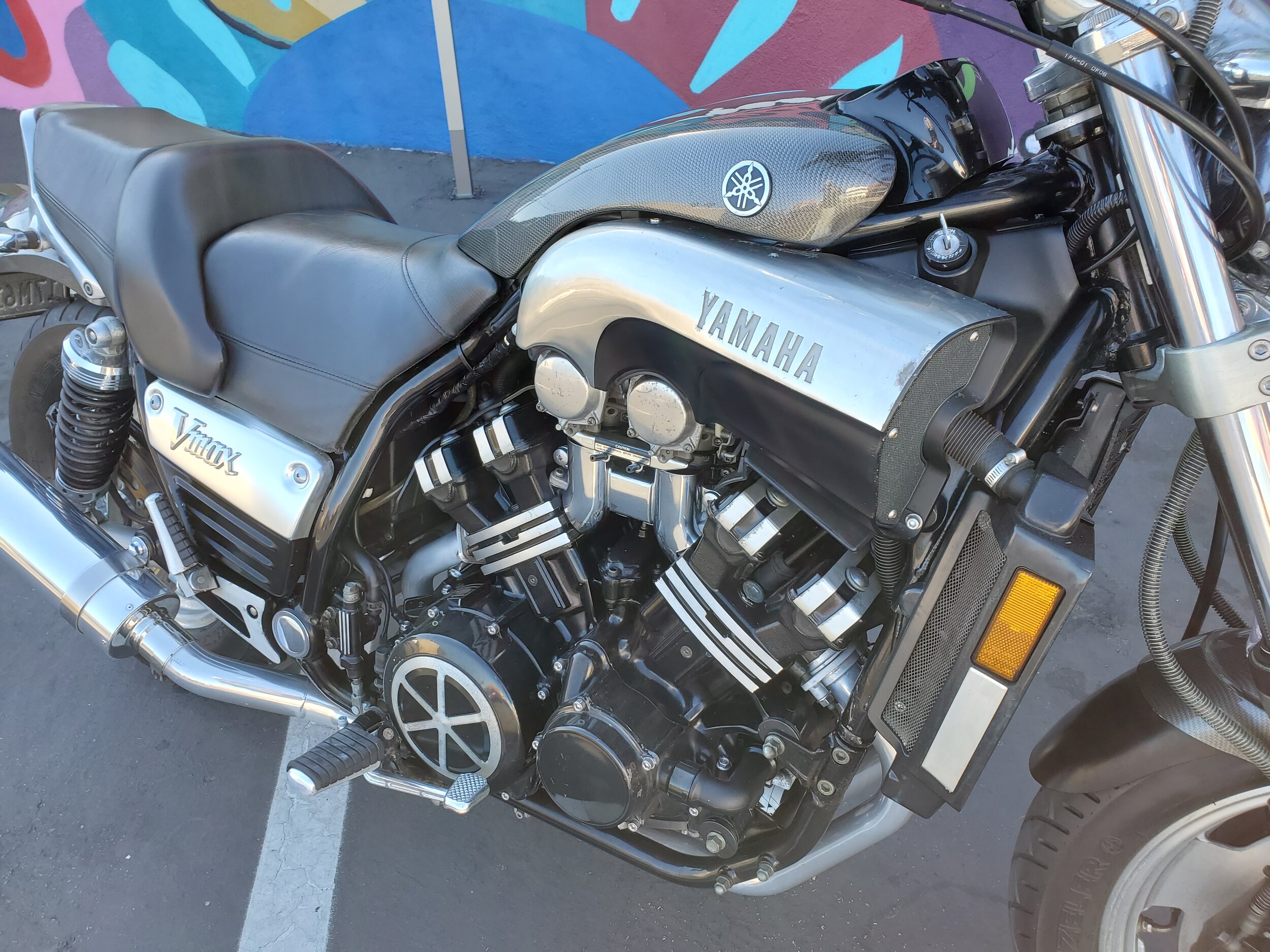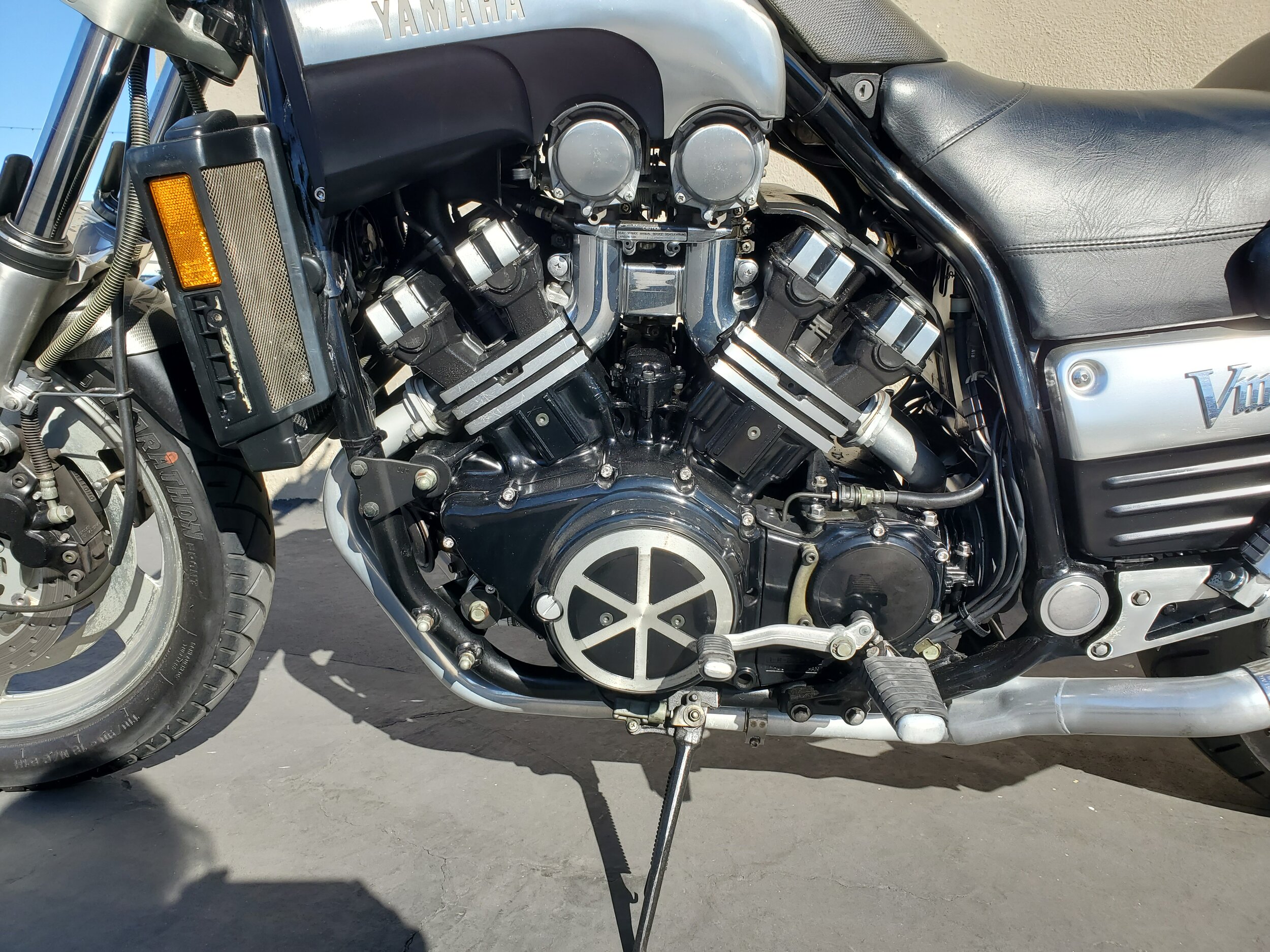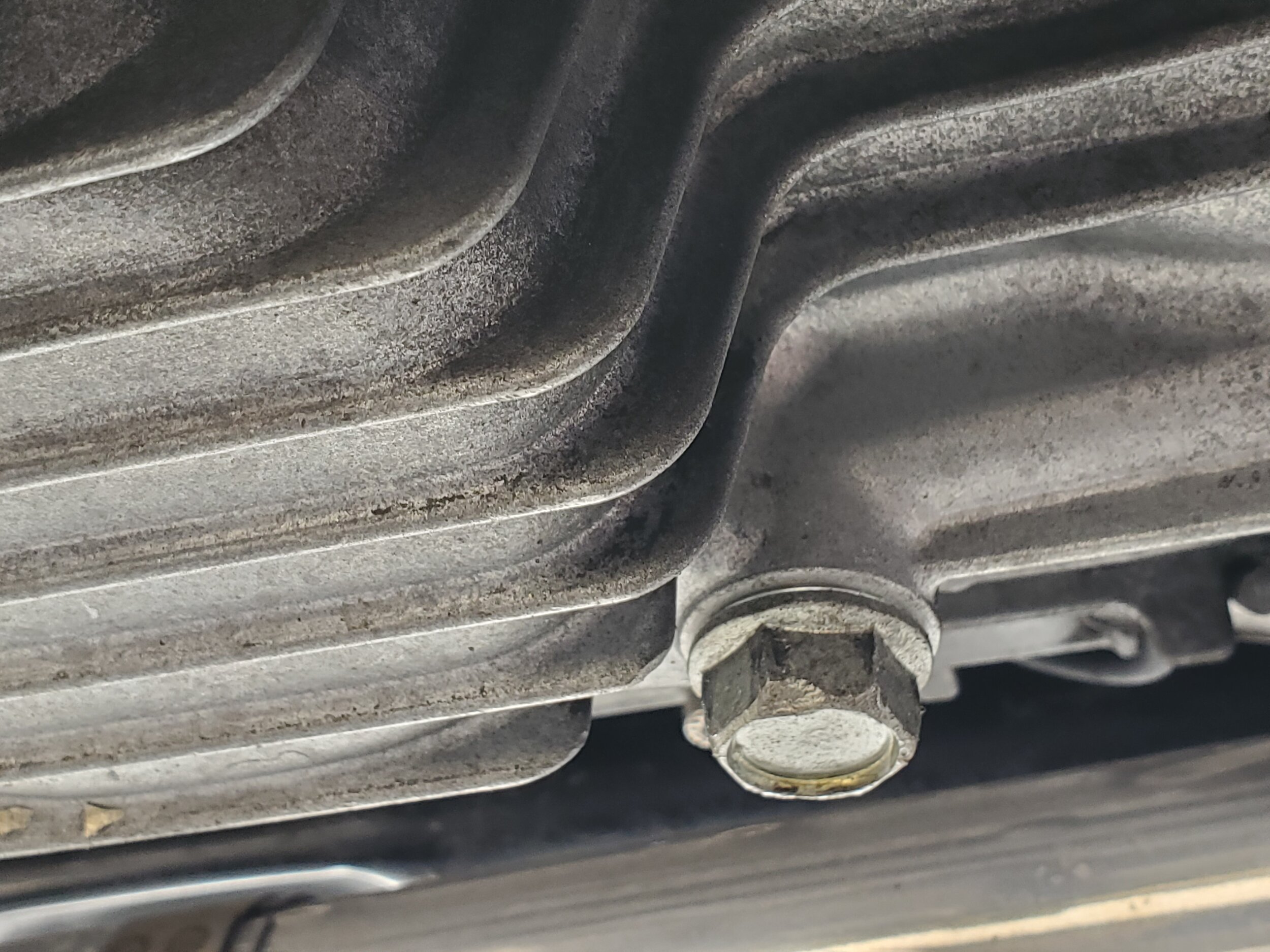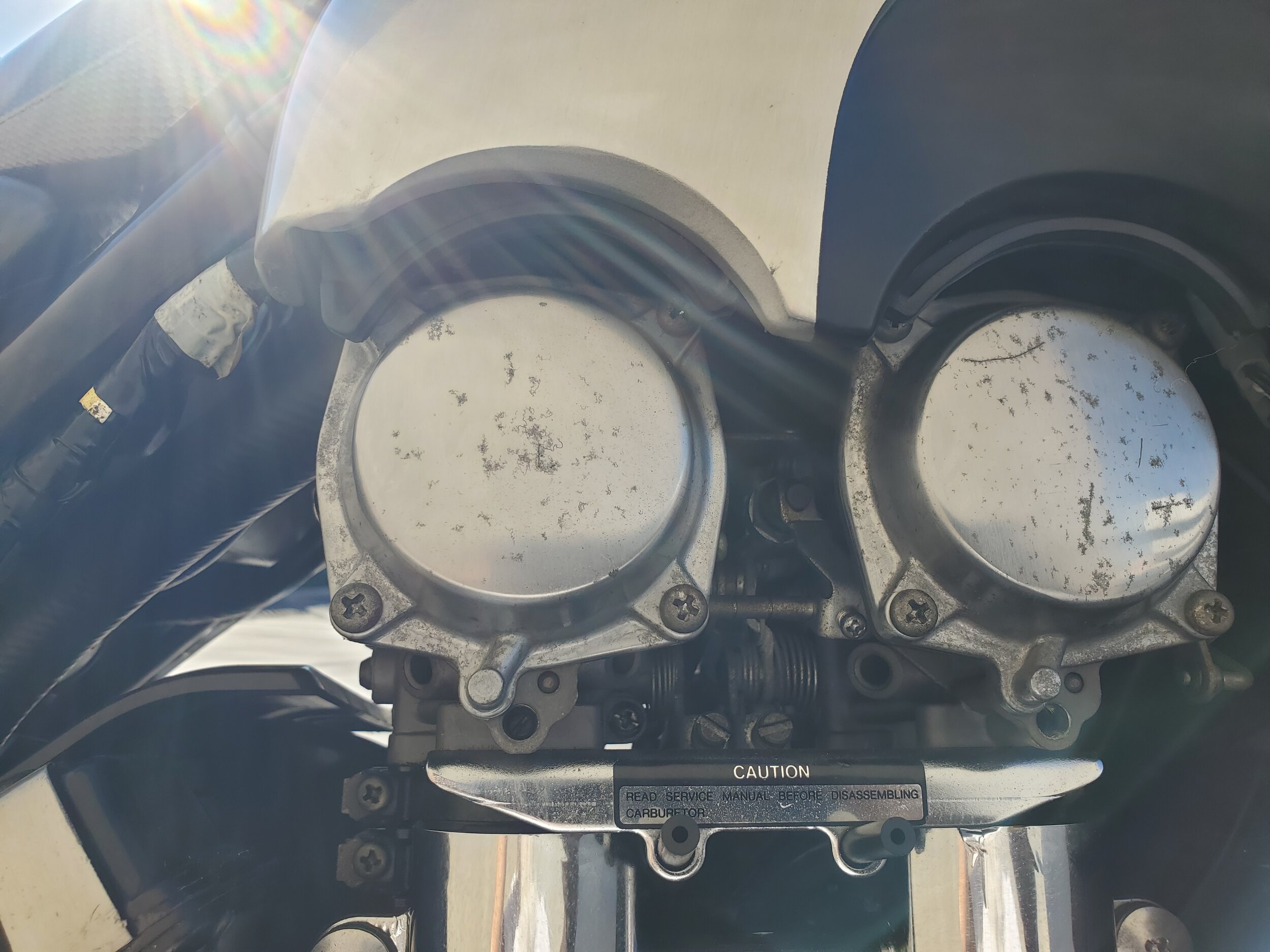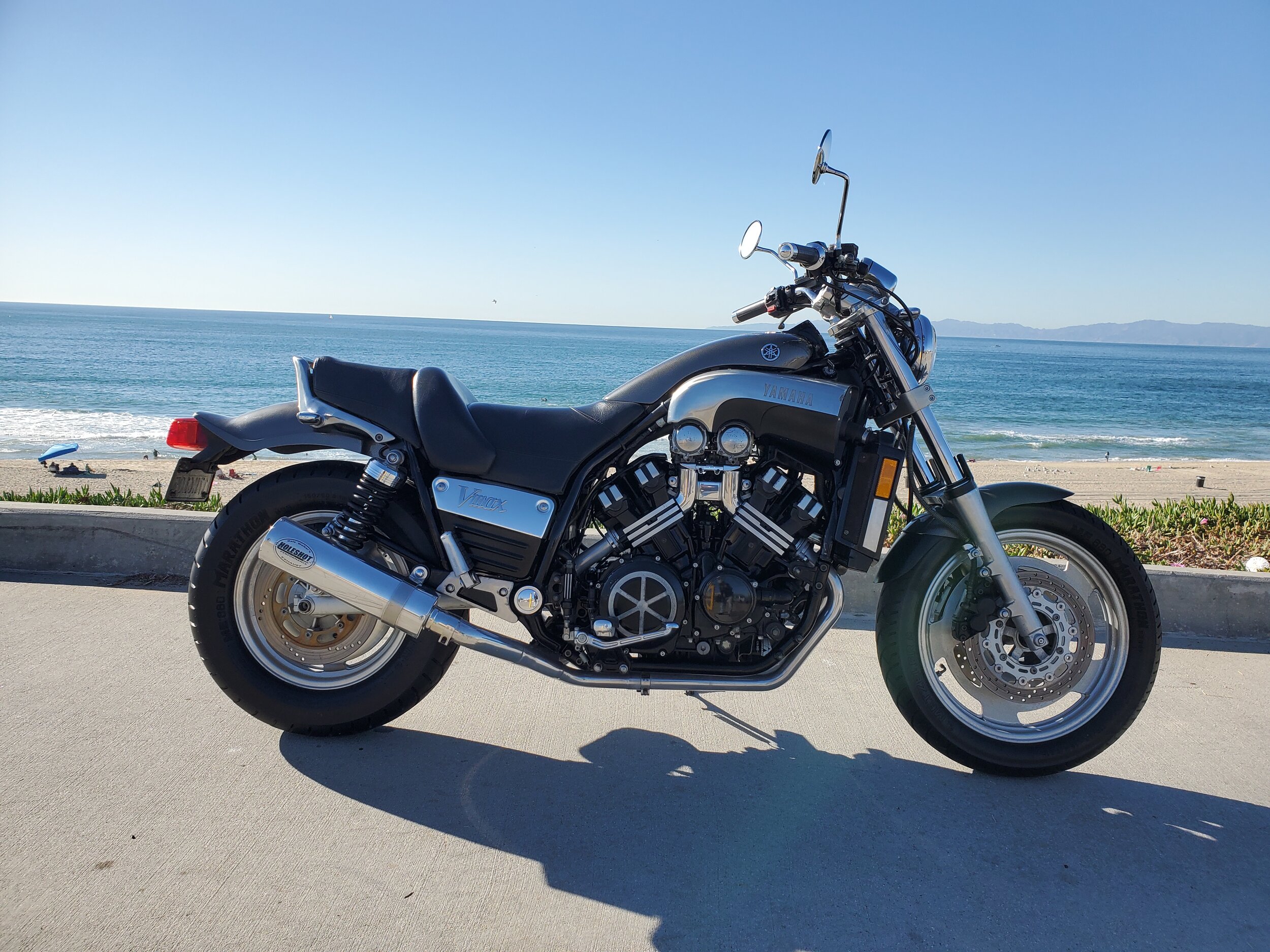2001 Yamaha V-Max 1200 - $6,995 SOLD
VIN: JYA2WEE0X1A082324
The Original Muscle Bike
From Info I was given bike was sold new in California and remained with the original owner, who had the performance modifications done, owned the bike through 2017. Second owner Sold to enthusiast / mechanic in October of 2019. While in his possession he rebuilt the transmission, new sliders & 2nd gear, all fresh gaskets on engine case and cam covers, installed a Barnett Racing High Performance Kit, tune up, fluid change. He also swapped out the speedo (broke the original case with about 22,300 miles showing} installed new speedo reading 13,432 miles. He never changed title to his name before he sold to me in August 2020. I am the third Registered Owner of the bike as far as I can tell.
Bike is pretty original other than Performance Modifications. Billet Aluminum fork brace by "Super Brace" has been installed to keep the forks stable. A Dale Walker's HOLESHOT Stainless Steel Performance Full 4 into 2 exhaust system & HOLESHOT PERFORMANCE Stage 1 Power package. Custom turn signals front and rear have been installed.
Bike really has no issues or problems at this time other than small cosmetic flaws. Both air box side covers have some light scratches and corrosion, corrosion and scratches, rock chips on fork legs and triple clamps, some corrosion & pitting on wheels & brake rotors. Very Light corrosion & pitting on engine cases and various covers and fasteners. There is a flaw in the Carbon Fiber finish on top of front fender. All other body work is in nice condition other than than slight chips and scratches.
No service records were passed along to me with the bike as they were not passed on by the second owner. I was told bike had been serviced per factory recommendations with additional oil changes. I did see receipts for the transmission rebuild parts but was not given a copy.
Service by last owner included Rebuilding the Transmission with new sliders & 2nd gear, new Barnett Racing Clutch Package, all fresh Fluids, Carbs cleaned & refreshed. Engine / transmission cases were sealed with new gaskets as were the cam covers. This service work was performed a couple months before I purchased the bike in August 2020.
The Yamaha V-Max 1200 was the Original Power Cruiser / Hooligan Bike that could break into the 10 second range in stock off the showroom trim!
This is a limited CARBON EDITION V-Max finished in a Carbon Fiber Look body work.
Bike looks great, rides excellent, sounds awesome, has tons of power (137.5 hp at rear wheel) When the V-Boost kicks in you better hold on tight! To over-simplify Ashihara’s V-Boost concept, at 6,000 rpm a little servo-motor kicked in and began opening a butterfly valve that separated the intakes of the two carbs on each bank of the V-four. And since the pistons were on different strokes, one side was not stealing from another. The boost was complete at 8,000 rpm, with the power maxing at 9,000 rpm. Cram that fuel in, spark the plug, and the factory was claiming 145 crankshaft horses.
This V-Max looks fast sitting still and sounds like a Full on Race bike!
Absolute Blast to ride.
VIN: JYA2WEE082324
MORE PHOTOS & INFO: https://freeagentmotorsports.com
Located in Redondo Beach California
Interesting info & History from RIDER MAGAZINE
1985 Yamaha VMX12N V-Max.
Too modern for Retrospective? Perhaps not. The V-Max appeared back in 1985, was on the books for ’86 then skipped ’87, only to reappear with new wheels in 1988, then lasted with minor changes for the next 20 years. This ’85 gem is the original.
The V-Max was a genuine butt-kicker, the likes of which had never been seen before. Yamaha called it a “muscle” bike, but if it were compared to Arnold pumping iron in ’85, he would have been stricken from the competition due to overuse of steroids.
The V-Max was all about muscle, little to do with practicality, even handling. The Japanese felt that the way to serious muscle was with a V-4, and the Max’s rear wheel showed 120 horsepower, with a 10-second (barely) quarter-mile. Its closest competition was the Honda Magna 1100 with 100 horses, and a half-second slower in the quarter. Third was Suzuki’s Madura 1200, with a mere 90 ponies and a quarter in the high 11s. Kawasaki, sensibly, decided to stay away from the internecine V-4 struggle.
The project was probably defined as building the most powerful cruiser yet, as cheaply as possible. At the Hamamatsu end, when the OK to go ahead was given, engine guru Mr. Ashihara was told to get some real horsepower out of the rather benign Venture touring motor, which was rated at about 90 horses. And Mr. Kurachi, the body designer, was detailed to create a look that would not be forgotten.
The 1,198cc Venture engine was a big-bore, liquid-cooled 70-degree V-4, with a 76mm bore and 66mm stroke, dual chain-driven overhead camshafts, four (shimmed) valves per cylinder and counterbalancers to limit the vibes. To give it more
performance, the cams were reground to provide increased low-end power, but it was the top end that achieved startling results. Basically, the more combustibles one can jam into the cylinder, the bigger the explosion and the more power. The valves were increased in size, and the Venture’s 34mm Mikunis were upped to 35mm, with each cylinder fueled by its own carb. And then something new was added: V-Boost. To over-simplify Ashihara’s V-Boost concept, at 6,000 rpm a little servo-motor kicked in and began opening a butterfly valve that separated the intakes of the two carbs on each bank of the V-four. And since the pistons were on different strokes, one side was not stealing from another. The boost was complete at 8,000 rpm, with the power maxing at 9,000 rpm. Cram that fuel in, spark the plug, and the factory was claiming 145 crankshaft horses.
There was one minor drawback to all this complication with the air-induction system, which included a large airbox under the cover that looked like a gas tank, and that was that the fuel tank had to be placed under the seat and held a mere four gallons. With “average” fuel consumption in the low 30s, this meant the bike had about a 100-mile range before the rider began to worry. But in truth, the V-Max was not intended to be ridden more than a century at a stretch, one reason being the rather uncomfortable saddle. The neophyte needed to learn that when the low-fuel warning light came on, the switch for the reserve was a button by the right thumb.
Power passed through a 5-speed gearbox, vaguely similar to the one on the Venture. Gear ratios had been altered, with the gears reinforced and a new diaphragm clutch to help control all those horses. Final drive was by shaft, surprisingly, but obviously the engineers felt the engine was so strong they could waste a few horses.
The frame was a workmanlike tubular-steel cradle. The air-adjustable 40mm Kayaba fork was connected, fortunately, so only a single valve was needed; rake was a stable 29 degrees, trail, 4.7 inches. The twin shocks, also Kayaba, had preload and rebound damping adjustability. Reviewers generally liked its road-holding characteristics, but apparently did not want to try it out on road-racing tracks, so the lean-angle limits never seemed to be mentioned. It was certainly no competition for the FZ750.
The front wheel was an 18-incher, with a 100/90 tire and a pair of 282mm discs with two-piston calipers. The rear mag was a whopping great (for the time) 3.50 x 15, sporting a ginormous 150/90 piece of rubber. With a tire that big, the bike did like to stand up in the corners. And if the rider chose to ride in straight lines and flatten the middle portion of the tire, the tendency to stand up was increased. A two-piston caliper squeezed a single disc at the back.
Dimensions were weighty, almost 620 pounds with fuel in the canister. And lengthy—more than 62 inches between axles—much due to the drive shaft that was built long in an effort to reduce the infamous jacking aspect.
And the look was good. The angular cruisers that the Japanese had introduced in the early 1980s were more interesting than appealing, but the flair that Kurachi created was to become almost legendary. Namely with the fake scoops that looked as though they rammed air into the carbs. The big speedo up above the headlight had rather a Vincent Black Shadow look. Our 1985 photo model has the dealer-installed pinstripe kit, a factory option.
The V-Max immediately muscled its way to the lead in its category. The competition dropped out after 1986, Suzuki discontinuing the Madura, Honda the big Magna. Granted, this was a troubling time in the U.S. economy, as a middling recession had begun in the early 1980s. Unsold bikes, “non-currents” being the operative word, were everywhere, and even Yamaha did not produce a 1987 V-Max, having too many ’86 models left in showrooms and warehouses.
While the naysayers began to write obituaries, the V-Max came back in 1988, with new wheels. Future changes were minor: In 1990 the ignition was upgraded to digital electronic, and in ’93 some chassis changes were made, with 43mm fork tubes bolted on to do away with any flex. It received a few additional mods, but the V-Max stayed pretty much the same old, same old. Because it still garnered new customers. Impressive.
Located in Redondo Beach California





































